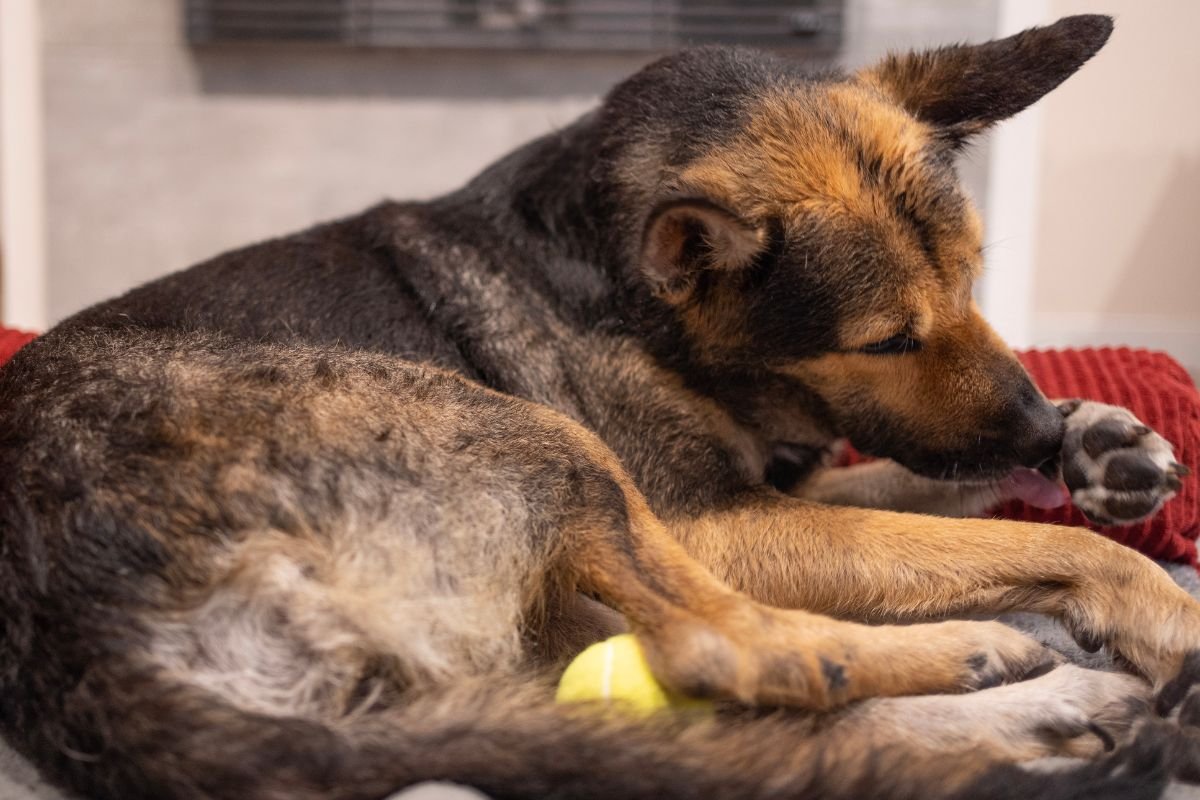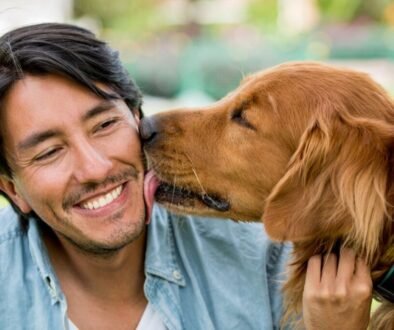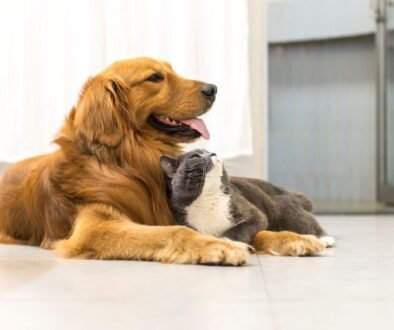Why Do Dogs Lick Their Paws, Understanding the Mystery Behind This Common Behavior
A Puzzling Habit
Have you ever caught your dog licking their paws as if it’s their favorite pastime? This puzzling habit might seem harmless, but it can sometimes signal underlying issues.
For many dog owners, paw-licking is a common sight—but when it becomes excessive, it’s hard not to worry. Could it be allergies? Stress? Something stuck between their toes? This blog unravels the mystery behind paw-licking, explaining the normal, the concerning, and the actionable steps you can take to help your furry friend.
As Mark Twain once said, “The more I learn about people, the more I like my dog.” Let’s learn a little more about why our loyal companions engage in this curious behavior and how to ensure their well-being.
Is Paw-Licking Normal?
The short answer: Yes, but it depends. Dogs lick their paws for many reasons, and some of them are perfectly natural. Occasional paw-licking is a normal grooming behavior, much like how cats clean their fur. But when the licking becomes excessive, it might indicate an underlying problem that needs attention.
Occasional vs. Excessive Licking
- Occasional Licking: This is harmless. It’s usually part of a dog’s self-grooming routine, like cleaning off dirt after a walk.
- Excessive Licking: If your dog licks their paws to the point of causing redness, irritation, or even sores, it might indicate an issue that needs attention.
The Reasons Dogs Lick Their Paws

Understanding why dogs lick their paws is key to addressing the behavior. Let’s explore the most common causes.
- Grooming and Hygiene
Dogs are naturally clean animals. They lick their paws to remove dirt, mud, or debris. After a messy play session or a walk through wet grass, paw-licking is their way of freshening up.
Fun Fact: Dogs’ saliva contains some natural antibacterial compounds, but it also carries bacteria that could potentially cause infections. It’s best to clean wounds with proper antiseptics.
- Allergies
Allergies are one of the most common reasons for excessive paw-licking. Dogs can be allergic to:
- Food: Ingredients like chicken, beef, or grains.
- Environmental Triggers: Pollen, mold, or dust mites.
- Contact Allergens: Grass, cleaning products, or certain fabrics.
Allergic reactions often cause itching, and paw-licking is your dog’s way of trying to relieve it.
- Injuries and Pain
A tiny thorn, a splinter, or even a minor burn from walking on hot pavement can cause discomfort, leading to licking. Dogs might also lick if they have a broken nail or a small cut.
How to Spot an Injury: Check for swelling, redness, or signs of tenderness.
- Anxiety or Stress
Dogs, like humans, can feel anxious or stressed. Paw-licking is sometimes a coping mechanism, similar to how people bite their nails. Triggers might include:
- Being left alone for long periods (separation anxiety).
- Loud noises like fireworks or thunderstorms.
- Changes in their environment, such as a move or a new pet in the house.
- Boredom
When dogs don’t get enough mental stimulation or physical exercise, they might resort to paw-licking as a way to pass the time. Boredom-related licking often happens in dogs left alone for extended periods.
Signs of Boredom: Chewing furniture, digging, or pacing.
- Parasites and Skin Conditions
Fleas, ticks, or mites can make your dog’s paws unbearably itchy. Skin infections like yeast or bacterial overgrowth can also cause irritation.
Tip: Regular grooming and vet checkups can prevent many parasite-related problems.
- Other Medical Concerns
- Arthritis: Older dogs might lick their paws due to joint pain.
- Hormonal Imbalances: Conditions like hypothyroidism can cause dry, itchy skin.
- Foreign Bodies: Something stuck between the paw pads can lead to compulsive licking.
When to Seek Veterinary Help

If your dog’s paw-licking is accompanied by any of the following, consult your vet:
- Swelling or bleeding.
- Redness or sores that don’t heal.
- Signs of pain or limping.
- Persistent licking that interferes with daily activities.
Your vet might recommend diagnostic tests, like skin scrapings, allergy testing, or X-rays, to identify the root cause.
Home Remedies and Solutions
For minor issues, here are some simple steps you can try at home:
- Clean Their Paws Regularly: After walks, use a damp cloth or pet-safe wipes to remove allergens or debris.
Pro Tip: Keep a small towel by the door to wipe your dog’s paws after outdoor play. This easy routine can help prevent paw-licking caused by allergens or debris. - Apply Soothing Balms: Use dog-friendly paw balms to treat dryness or minor irritations.
- Keep Nails Trimmed: Regularly trimming your dog’s nails can prevent discomfort and reduce licking.
- Use Booties: Protect your dog’s paws in extreme weather or on harsh surfaces.
Pro Tip: In summer, lightweight booties can shield your dog’s paws from hot pavement. Alternatively, stick to shaded areas during walks. - Enrichment Activities: Offer puzzle toys, training sessions, or interactive games to keep your dog engaged and combat boredom.
Did You Know? Interactive toys and puzzle feeders are excellent boredom-busters that may help curb compulsive licking behaviors. - Dietary Adjustments: If you suspect food allergies, consult your vet about transitioning to a hypoallergenic diet.
Conclusion: Keep Those Paws Happy!
Dogs lick their paws for various reasons, from grooming and allergies to boredom and stress. While occasional licking is perfectly normal, excessive licking is a sign that something might be wrong. By understanding the causes and taking proactive steps, you can help your furry friend live a happier, itch-free life.
Remember, you know your dog best. If something seems off, don’t hesitate to consult a veterinarian. After all, happy paws make for a happy pup—and a happy pup makes for a happy you!
FAQs About Paw-Licking in Dogs
Q: How much paw-licking is too much?
A: Occasional licking is normal, but if it becomes obsessive or leads to irritation, redness, or wounds, it’s time to act.
Q: Can I stop my dog from licking their paws?
A: Yes! Identify the root cause and address it. Use deterrent sprays, paw balms, or protective booties as needed, and consult your vet if the problem persists.
Q: Are certain dog breeds more prone to paw-licking?
A: Breeds like Golden Retrievers, Bulldogs, and German Shepherds are more prone to allergies due to their genetic predispositions or common skin conditions, which can lead to paw-licking.
Q: Could paw-licking be a sign of pain?
A: Yes, especially in older dogs. Arthritis or injuries can cause discomfort, leading to licking as a way to soothe the pain.
Q: Can licking their paws be related to diet?
A: Yes, food allergies are a common trigger for paw-licking. Ingredients like chicken, beef, dairy, or grains could be causing your dog discomfort. If you suspect this, consult your vet about trying an elimination diet or switching to hypoallergenic dog food.
Q: Is paw-licking seasonal or year-round?
A: It can be either. Seasonal allergies to pollen or grass often cause increased licking during specific times of the year. If your dog’s licking persists year-round, it could be due to other factors like food allergies, stress, or chronic skin conditions.
Q: What can I do if my dog is licking their paws after a walk?
A: Gently wipe their paws with a damp cloth or pet-safe wipes to remove any irritants like dirt, salt, or chemicals. If licking continues, check for small cuts, debris, or redness.
Q: How do I tell if paw-licking is anxiety-related?
A: Anxiety-related licking is often accompanied by other signs, such as pacing, whining, or destructive behavior. Triggers like loud noises, being left alone, or changes in their routine can increase this behavior. Providing calming toys, pheromone sprays, or extra attention might help.



